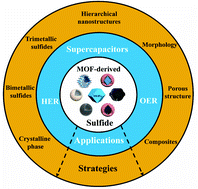Recent progress in water-splitting and supercapacitor electrode materials based on MOF-derived sulfides
Abstract
Metal–organic frameworks (MOFs) are being extensively reported as ideal templates or precursors for energy storage and conversion materials thanks to their unique architectures with high surface area, high ordered porosity, the concentration of heteroatoms, and adjustable structures, allied with the possibility of carrying out chemical processes while preserving their structure and enhancing or incorporating new properties, and essential features for the rational design of multifunctional electrode materials for energy technologies. In fact, MOF-derived materials exhibit versatile nanostructures, outstanding electrochemical performances and stability, overcoming the relatively low conductivity of MOF precursors. In this review, the recent progress on MOF-derived sulfide-based electrode materials for energy applications are summarized. The main strategies used for the design of MOF-derived sulfides for supercapacitors and the current trends as electrocatalysts for water-splitting, more specifically for HER and OER are discussed. Finally, perspectives and possible insights into the future development of MOF-derived electrode materials toward a more sustainable society are anticipated.

- This article is part of the themed collection: Editor’s Choice 2023: Advancing electrocatalysts for a sustainable future.


 Please wait while we load your content...
Please wait while we load your content...